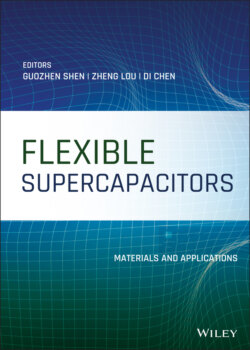Читать книгу Flexible Supercapacitors - Группа авторов - Страница 26
2.1 Overview of Stretchable Supercapacitors
ОглавлениеStretchable supercapacitors (SCs) that possess both flexibility and stretchability in terms of mechanical property and easy integration in terms of whole electro circuit design have attracted plenty of interest because they fulfill the demands of wearable or skin‐attachable electronic devices on energy storage [1–5]. By couple with stretchable SCs, portable/ wearable devices could easily realize the special health monitor and chemical, physical, biological, etc. signal detection without impacting on the size, volume, mass of the wearable electronic [6–8]. Current stretchable SCs are composed of deformable substrate, electrode materials, and all‐solid‐state electrolyte, which are much simplified in comparison with traditional SCs that contain two other components: current collector and separator.
The energy storage mechanism of stretchable SCs is similar to traditional SCs, which can be divided into pseudocapacitors and electrical double‐layer capacitors (EDLCs) according to the used electrode materials [9–12]. These two kinds of SCs have their merit and shortcoming, pseudocapacitors presented by the metal oxides, conductive polymers and nanocomposites possess the advantages of much higher capacitance owing to the reversible faradaic reactions at the electrode/electrolyte interface, for example, the theoretical‐capacitance value of two‐dimensional layered double hydroxide electrode materials is as high as 3000 F g−1, but suffer from poor cycling life, inferior rate capability and relatively low conductivity [13–17]. Porous carbon materials based EDLCs with benefits of ultra‐long cycling life, high power density, good chemical stability, non‐toxic and environmental friendliness are of importance for SCs, but their specific capacitance is limited to fewer than about 300 F g−1 [18–22]. The electrochemical performance like specific capacitance, stability, lifespan etc. under different deformation is a basal parameter in the process of development of stretchable SCs, must be considered.
Stretchable substrate, which could assist the energy storage to be fabricated or integrated on clothes and the human body, is highly desirable for wearable electronic devices because human skin and human body activity often go along with a certain extent of stretchability [23, 24]. Polydimethylsiloxane (PDMS) is the most frequent use substrate in the stretchable devices owing to its high strain (>100%), which is much stronger than that of stainless steel mesh (~20%) [25–27]. There are many other typical stretchable substrates, such as polyurethane (PU) [28], elastic yarns, thermoplastic polyurethanes (TPU), thermoplastic elastomer (TPE) [29] with properties of large strain and free shape, which make stretchable devices work excellent under various deformation. Self‐healability as an attractive high elasticity has been included into stretchable substrate, which could get the wearable devices back to life while the devices inevitably encounter malfunction during their lifetime. Several kinds of self‐healable substrates like polyvinyl alcohol (PVA) [30], polyacrylic acid (PAA) [31], polyacrylamide (PAM) [32] have been synthesized in recent years.
All‐solid‐state gel electrolytes are one of the essential components for stretchable SCs in design of fully wearable energy storage devices, which could protect SCs from the risks of liquid leakage and simplify the device configurations of the SCs by removing the extra separator and substrates of the devices. On the basis of solvent type, gel electrolytes are generally considered to fall into the below two categories: hydrogel electrolyte and organic ions/solvent‐based gel electrolyte. The ionic conductivity of hydrogel electrolyte can reach 10−4 S cm−1, up to 10−1 S cm−1 [2]. Organic gel electrolyte exhibits excellent stability in air and enhanced electrochemical performance by adding organic ions to electrolyte, which is a unique way to improve the electrochemical properties of SCs devices.
To date, many achievements have been made to fabricate stretchable SCs that include both 1D fiber SCs, 2D planar SCs and 3D structured SCs [33, 34]. The fiber shaped energy devices have been woven into flexible energy textiles while and the planar devices have been proved that they could be attached to the human body. Figure 2.1 presents the typical 1D, 2D, and 3D stretchable SCs and their application in wearable electronics, as well as the multifunctional stretchable SCs contain self‐healable SCs, compressible SCs, and their integration with other wearable devices.
In this chapter, we focus on the recent progress in stretchable SCs and their potential application in wearable electronics. First, the main approaches to assemble stretchable SCs consist of both 1D fiber and 2D planar devices are presented. Then, we describe the main electrochemical and mechanical performances in the field of the stretchable SCs. The multifunctional SCs such as self‐healable SCs, compressible SCs and the self‐powered integrated system are also highlighted. Finally, we discuss the existing challenges and future development trends for stretchable SCs.
